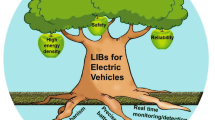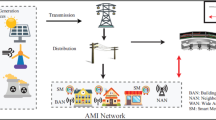Abstract
This paper presents results from experimental studies carried out using an electronic device called a Dimmer Flex, developed at the Federal University of Mato Grosso, Brazil. The Dimmer Flex is able to evaluate the effects of electronically switched loads regarding electrical measurements, especially focusing on billing. It can be concluded from the studies that, depending on the switching characteristics, a switched load can be “transformed” to the meter in a load with inductive or capacitive behavior, therefore “absorbing or injecting” reactive power to the system it is connected to. This finding shows that electronically switched loads can interfere in electrical measurements and consequently may affect the billing process, underlining the need to evaluate, discuss and even review current measurement and billing methods.















Similar content being viewed by others
References
ANEEL. (2012). Technical Note No. 0083/2012 – SRD/ANEEL. Brazilian Electricity Regulatory Agency. Technical Note. Brasília.
ANEEL. Normative Resolution No. 414, of September 9,. (2010). Establishes the general conditions for the supply of electric energy (p. 2010). Brasília, September: Brazilian Electricity Regulatory Agency. Normative Resolution.
Belchior, F.N., Galvão, T.M., Ribeiro, P.F., Silveira, P.M. (2015). Comparative analysis of power quality instruments in measuring power under distorted conditions. International Journal of Emerging Electric Power Systems, 16(5), 421–429. ISSN (Online) 1553-779X, ISSN (Print) 2194-5756, 2015.
Beltran-Carbajal, F., & Silva-Navarro, G. (2017). A fast parametric estimation approach of signals with multiple frequency harmonics. Electric Power Systems Research, 144, 157–162.
Cataliotti, A., Cosentino, V., Lipari, A., & Nuccio, S. (2009). Metrological characterization and operating principle identification of static meters for reactive energy: an experimental approach under nonsinusoidal test conditions. IEEE Transactions on Instrumentation and Measurement, 58(5), 1427–1435.
do Alves, H. N. (2016). Power factor correction and harmonic filtering planning in electrical distribution network. Journal of Control, Automation and Electrical Systems, 4, 1–11.
Fernandez, F. M., & Nair, P. S. C. (2011). A new expression for power factor under nonsinusoidal conditions. In Innovative Smart Grid Technologies - India (ISGT India) 2011 IEEE PES, (pp. 155–159).
Ferreira, D. D., Nagata, E. A., Ferreira, S. C., de Seixas, J. M., Duque, C. A., Marques, C. A. G., et al. (2015). Method based on independent component analysis for harmonic extraction from power system signals. Electric Power Systems Research, 119, 19–24.
Fiorucci, E. (2015). The measurement of actual apparent power and actual reactive power from the instantaneous power signals in single-phase and three-phase systems. Electric Power Systems Research, 121, 227–242.
Hansen, S., Nielsen, P., & Blaabjerg, F. (2000). Harmonic cancellation by mixing nonlinear single-phase and three-phase loads. IEEE Transactions on Industry Applications, 36(1), 152–159.
IEEE. (2010). Standard definitions for the measurement of electric power quantities under sinusoidal, nonsinusoidal, balanced, or unbalanced conditions. In IEEE Std 1459-2010 (Revision of IEEE Std 1459-2000), (pp. 1–40).
Osnach, A. M. (2010). Power components in a circuit under nonsinusoidal conditions. In Proceedings of 14th international conference on harmonics and quality of power (ICHQP), 2010, Bergamo, Italy, (pp. 1–5).
Paredes, H. K. M. (2011). Conservative power theory: A new approach to cooperative control of power conditioners and considerations regarding to responsibility assignment. PhD Thesis. University of Campinas. Campinas, March 2011.
Passos, F. O., de Carvalho Filho, J. M., Leborgne, R. C., Silveira, P. M., & Ribeiro, P. F. (2015). An alternative approach to locating voltage sag source side at the point of common coupling based on power-flow information. Journal of Control, Automation and Electrical Systems, 26(5), 579–587.
Rodrigues, J. E. (2009). Harmonic interference in equipment for measurement of electrical energy. Master’s Dissertation. University of São Paulo. São Paulo, June 2009.
Santilio, F. P., Vasconcellos, A. B., Silva, R. P. B. da., Malheiro, T. I. R. C., & Schlischting, M. W. (2015). Study of reactive flow of split-type air conditioners and inverter air conditioners in the consumer units and the public electricity companies. In XI Brazilian conference on power quality (CBQEE), 2015, Campina grande.
Sepulchro, W., do, N., Encarnação, L. F., & Brunoro, M. (2014). Harmonic state and power flow estimation in distribution systems using evolutionary strategy. Journal of Control, Automation and Electrical Systems, 25(3), 358–367.
Sousa, C. V., de Rezende, G. M., Matos, F. F., Silva, S. R., & Mendes, V. F. (2016). Regenerative active electronic load for testing power transformers under linear and nonlinear conditions. Journal of Control, Automation and Electrical Systems, 27(1), 105–117.
Souza, W. A., Liberado, E. V., Silva, L. C. P. da., Paredes, H. K. M., & Marafão, F. P. (2013). Load analyser using conservative power theory. In XI international school on nonsinusoidal currents and compensation (ISNCC), 2013, Zielona Gora, Poland, (pp. 1–6).
Suhett, M. R. (2008). Analysis of techniques used for the measurement of reactive power by static meters. Master’s Dissertation. Federal University of Rio de Janeiro, Rio de Janeiro.
Thomas, J. P., Revuelta, P. S., Vallés, A. P., & Litrán, S. P. (2016). Practical evaluation of unbalance and harmonic distortion in power conditioning. Electric Power Systems Research, 141, 487–499.
Vieira, D. (2012). Comparison of reactive power measurement techniques under non-sinusoidal conditions focused on wavelet transform. Master’s Dissertation. University of Brasília. Brasília, March 2012.
Witherden, M. S., Rayudu, R., & Rigo-Mariani, R. (2010). The influence of nonlinear loads on the power quality of the New Zealand low voltage electrical power distribution network. In Universities power engineering conference (AUPEC), 2010 20th Australasian (pp. 1–6).
Author information
Authors and Affiliations
Corresponding author
Rights and permissions
About this article
Cite this article
da Silva, R.P.B., Quadros, R., Santilio, F.P. et al. Effects of Electronic Loads on Electrical Measurements, Power Quality and Billing. J Control Autom Electr Syst 28, 654–663 (2017). https://doi.org/10.1007/s40313-017-0330-2
Received:
Revised:
Accepted:
Published:
Issue Date:
DOI: https://doi.org/10.1007/s40313-017-0330-2




